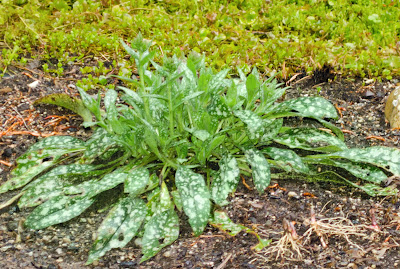It's raining again. As usual. The sky is grey, the ocean is grey, the distant mountains are grey. But the lichens! Oh, the lichens!
These leafy lichens are pale, bluish green, fading to dark brown in the summer heat. But give them a good bath, and they quickly turn this bright, saturated green.
The underside of the thalli (leaf-like structures) is brown with whitish patches. On lichens over 25 years old, tiny reproductive structures form on the surface of the thalli, like little discs or powdery spots. A few are visible on the edges of some thalli in the photo.
The lichen is common throughout our low-lying coastal forests, growing mainly on trees, sometimes on rocks.
 |
| Tree trunk in party dress. Miracle Beach forest. |
Long, long ago, we were taught that a lichen is a symbiotic organism consisting of a fungus living with a green alga. That was amazing enough, but in recent years, we've learned that it's a three-kingdom arrangement; a fungus, from the Fungi kingdom, a green alga (Protista kingdom), and a cyanobacteria (Eubacteria kingdom). The mind boggles.
~~~~~~~~~~~~~~~~~~~
Está lloviendo otra vez. Como siempre. El cielo es gris, el mar es gris, las montañas distantes son grises. ¡Pero estos líquenes! ¡Ah, estos líquenes!
Fotos: líquen Lobaria pulmonaria, en una rama, y vistiendo el tronco de un árbol, acompañado de musgos.
Estos líquenes foliosos son de un color verde pálido, volviéndose color café oscuro en el calor del verano. Pero llega la lluvia, y de inmediato se vuelven de este color verde brillante. La parte inferior de los talos (como hojas) es café con manchas blancas.
En las pulmonarias de la edad de 25 años o más, se forman pequeñas estructuras reproductivas, como círculos o polvo en el talo. Se pueden ver algunas de estas en la primera foto.
La pulmonaria se encuentra comunmente creciendo sobre árboles en nuestros bosques húmedos en tierras costeras.
Hace muchos, muchos años, nos decían que los líquenes eran una combinación en simbiosis de dos organismos: un hongo, y un alga verde. Algo asombroso para contemplar. Pero recientemente, hemos aprendido que consiste en una relación de tres reinos: un hongo, del reino Fungi, un alga verde, del reino Protista, y un cianobacteria, del reino Eubacteria. ¡Increíble!




































